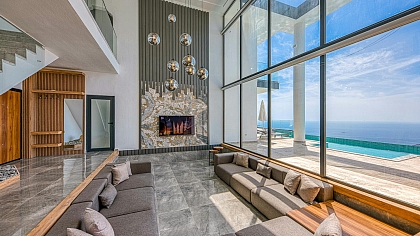
Slow Furniture for Fast Spaces: Handcrafted Pieces That Outlast Trends
Furniture today often feels rushed… made quickly, sold quickly, and replaced even faster. Styles change overnight, and what once felt exciting can start to look outdated before the year is over. Yet behind all the noise of fast trends, there's a steady return to something more lasting: handcrafted furniture built with care and meant to stay.
Slow furniture isn't about clinging to the past. It's about selecting pieces that have genuine weight, purpose, and craftsmanship behind them. These are the pieces that move with you through changing spaces and evolving styles, without ever losing their place.
What makes slow furniture the right choice for fast spaces, and how can it outlast everything else?
What Is Slow Furniture? Origins and Core Principles
Slow furniture is built around three lasting ideas: sustainability, quality, and timeless design. Unlike mass-produced pieces made to follow short-lived trends, slow furniture focuses on genuine materials and meticulous construction, designed to last for generations. Each piece is designed to be repaired and reused rather than replaced, making it a smarter, more responsible choice for individuals who want their homes to evolve with them, not work against them.
These principles are clearly evident in Amish Shaker furniture, known for its clean lines, sturdy joinery, and emphasis on function over decoration. Shaker designs crafted by Amish artisans stand as some of the finest examples of slow furniture today. These pieces aren’t made to grab attention or chase after the latest styles. Instead, they’re made to serve quietly, reliably, and beautifully using techniques and traditions passed down for hundreds of years.

Slow furniture is closely tied to the broader "slow living" movement, which encourages living with greater intention and rejecting the constant turnover of consumer goods. It’s a mindset found across cultures. In Japan, for example, the concept of ikigai, which is finding purpose and satisfaction in daily choices, has shaped how many people approach their homes. It connects the growing popularity of "slow decorating" to a stronger focus on sustainability and creating living spaces with deeper personal meaning, both key ideas behind slow furniture.
Why Handcrafted Furniture Matters Today
Durability is one of the primary reasons people opt for handcrafted furniture today. Built from solid wood, such as oak, cherry, or maple, these pieces are designed to last through generations of daily use. Many Amish families still inherit their great-grandfathers’ Amish Gliders, with the smooth rockers still working perfectly after decades. Solid joinery, thick boards, and hand-finished surfaces give handcrafted furniture a strength that mass-produced alternatives simply can’t match.
Beyond durability, sustainability is another major factor. Handcrafted pieces use less energy to produce, generate less waste, and often come from responsibly managed forests. There’s no reliance on disposable materials or assembly-line processes that pollute more than they produce. Choosing handcrafted furniture means investing in items that naturally fit into a lower-waste, environmentally conscious lifestyle without sacrificing style or comfort.
Health benefits also make a strong case for handmade furniture. Solid wood and natural finishes don’t release the same harmful chemicals found in many mass-market pieces, which can emit volatile organic compounds (VOCs) long after purchase. A home filled with natural materials supports better indoor air quality and promotes a calmer, more grounded environment, something increasingly important in today's fast-paced world. Add in the long-term economic value: owning one durable table or chair instead of buying five replacements. Handcrafted furniture is not just a luxury, but a smarter investment.
The Craftsmanship Behind Amish Furniture

Amish furniture-making relies on methods that have been passed down for generations. At Amish Furniture Factory, pieces are crafted using solid hardwoods, natural finishes, and woodworking techniques that prioritise precision and durability. Craftsmen prioritise functional design and structural integrity, focusing on creating furniture that can withstand decades of use without relying on shortcuts or mass-production methods.
The construction process begins with selecting high-quality domestic woods, such as oak, cherry, or maple. Joinery methods such as mortise and tenon joints are standard, providing strength without visible hardware. Craftsmen hand-finish surfaces with oils and stains, helping the wood age naturally. By focusing on the properties of each board, from its grain to its weight and moisture content, craftsmen ensure that each piece is sturdy, balanced, and built for long-term performance.
Common pieces produced through this approach include dining tables, bed frames, and storage furniture, all designed with clean lines and practical forms. Rather than reflecting short-lived design trends, these pieces tend to favour proportion, function, and simplicity, making them suited for a wide range of interiors. Through careful material selection and meticulous attention to detail in construction, Amish furniture maintains a consistently high standard of quality that supports both traditional and modern spaces.
How to Blend Slow Furniture with Modern Spaces
Handcrafted furniture can work with a wide range of design styles when approached with careful planning. Slow furniture brings warmth, structure, and character into spaces that might otherwise feel impersonal or overly uniform.
One effective way to integrate handcrafted pieces into a modern setting is by focusing on balance. A large, solid wood dining table, for example, can anchor an open-concept room without overwhelming it, especially when paired with clean, simple chairs and minimal decor. Choosing handcrafted items with straight lines and understated detailing allows them to blend seamlessly into contemporary interiors without clashing with surrounding modern materials, such as glass, metal, or polished concrete.
Another strategy is to treat slow furniture as focal points rather than trying to match everything in a room. A single handcrafted bench in an entryway or a solid wood coffee table in a living area can bring texture and depth without making the space feel heavy. Layering these pieces with modern lighting, neutral textiles, and streamlined accessories helps maintain a cohesive look. By blending traditional craftsmanship with modern simplicity, spaces feel more lived-in and balanced without losing their sense of structure.
How to Transition from Fast Furniture to Slow Furniture
Switching to slow furniture does not have to mean replacing everything at once. A thoughtful, step-by-step approach makes the transition easier and ensures that each new piece truly fits your space and needs.
The first step is to evaluate what you already have. Identify which pieces are still structurally sound and which ones are starting to show signs of poor quality, such as loose joints, sagging, or chipped finishes. It helps to prioritise replacing items that get the most daily use, such as dining chairs, bed frames, or sofas. By being selective, you avoid unnecessary waste and make sure each investment is practical.
Next, take time to research reputable sources for handcrafted furniture. Focus on makers who specialise in solid wood construction, sustainable practices, and transparent craftsmanship. A simple checklist can help: solid hardwood materials, traditional joinery methods, non-toxic finishes, and clear warranties or maker guarantees. Choosing slow furniture is not just about style; it’s about building a home with pieces that work harder, last longer, and hold deeper value over time.
Building Homes That Last Beyond Trends

Choosing slow furniture is more than a design decision. It’s a commitment to creating homes that are lived in, not just decorated, and spaces built around pieces that offer substance, stability, and lasting value. As homes continue to evolve faster than ever, handcrafted furniture provides something that fast trends can’t: continuity across years of change.
Amish Furniture Factory remains faithful to that tradition, offering solid wood pieces shaped with care, skill, and an understanding of what true craftsmanship means. In a time when almost everything feels replaceable, investing in furniture that’s made to stay is not just practical; it’s a way of living with greater purpose and intention.










